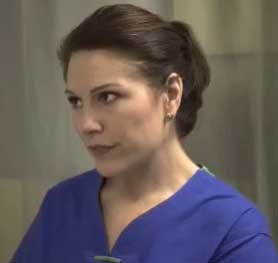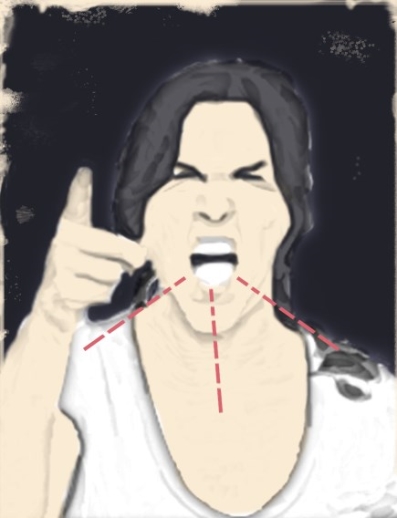


This module briefly reviews the Triple Aim for improving health care, presents a video case study in which the Triple Aim is not met, and analyzes types of interprofessional conflict and strategies for resolving them.

The ED Staff believe Anna needs to be admitted, possibly to the ICU.


The Triple Aim: Optimizing health, care and cost.
Institute for Healthcare Improvement, 2009
For additional information on each objective go to:
www.ihi.org
Let’s go back in time to Anna’s visit to the Oncology Clinic two days prior to her visit to the ED to see how the Triple Aims began to fall apart for her.

Dr. Park has a reputation for snapping at staff. He has been counseled that he has been dismissive of their concerns.

The nurse, Teresa, talks with her colleague.

As instructed, Anna has gone to the general infusion center to receive her antibiotics. After a long wait, she approaches the receptionist.

Dr. Park is surprised to see Anna still in the oncology clinic. He greets her saying, “You’re still here!” She explains that the infusion center could not do the blood draw, and she is going to the lab now. The doctor is frustrated and tells Anna to wait there for a minute while he finds a nurse.
Dr. Park stops Teresa and demands to know why the patient was sent to the infusion center. Without waiting for an answer, he states that Anna needs to be taken care of in oncology as he ordered.

Teresa reluctantly follows Dr. Park’s orders to accommodate Anna in the oncology infusion center.

Anna’s ride can’t wait any longer. Anna leaves without receiving the antibiotic infusion.


Put yourself in Anna’s position. Complete this patient satisfaction survey as if you were Anna.
Patient Satisfaction Survey | |||||
| Waiting | Great 5 |
Good 4 |
Ok 3 |
Fair 2 |
Poor 1 |
| Time in waiting room | |||||
| Time in exam room | |||||
| Waiting for tests to be performed | |||||
| Waiting for tests results |
| Staff – Provider: Physician, Dentist, Physician Assistant, Nurse Practitioner |
Great 5 |
Good 4 |
Ok 3 |
Fair 2 |
Poor 1 |
| Listens to you | |||||
| Takes enough time with you | |||||
| Explains what you want to know | |||||
| Gives you good advice and treatment |
| Staff – Nurses & Medical Assistants | Great 5 |
Good 4 |
Ok 3 |
Fair 2 |
Poor 1 |
| Friendly and helpful to you | |||||
| Answers your questions |
| Staff – All Others | Great 5 |
Good 4 |
Ok 3 |
Fair 2 |
Poor 1 |
| Friendly and helpful to you | |||||
| Answers your questions |
Anna Stevens was admitted from the ED with possible septicemia. However, two days earlier when she was in the oncology clinic, her condition was not that serious. There were at least three opportunities for the oncology team to advert this frustrating, painful and costly outcome for Anna.
Watch two videos and listen to one audio clip to consider these missed opportunities.

Conflict is endemic in healthcare, but not all conflict is the same. Identifying the type of conflict enables you to choose the strategy that will work best to resolve it.

Typically, we approach conflict without considering what type of conflict we are encountering. Your first challenge is to assess the type of conflict that you’re faced with.
With task-based conflict, our challenge is usually to speak up. We often have critical information for the situation, and we need to use a skill that allows us to find our voice. TeamSTEPPS strategies (such as CUS, Two Challenge Rule, and DESC script) are focused on these important skills.
In relationship-based conflicts, our challenge is to overcome the attribution errors and assumptions that we are making about the other person or team’s behavior. We need to use a skill that helps us to listen to the full story.
Finally, in situations where our colleagues are engaging in disruptive behavior, we are challenged to establish boundaries. In these situations, we need to communicate clearly what is acceptable behavior. The Joint Commission Sentinel Event Alert, Issue #40, “Behaviors that undermine a culture,” of safety addresses these relatively rare, but serious situations.
When you are faced with a conflict, your first task will be to decide what type of conflict you are facing. Then you must choose the best strategy to approach it. The remainder of this module will focus on strategies for relationship-based conflict.

Find one’s voice

Find one’s ears

Find one’s boundaries

We suggest a four-step framework for approaching relationship-based conflict. Click on each button below to learn more about each step.
1. Get Ready
2. Create Space
3. Do the work
4. Close & Affirm
Click here to learn more about conflict in the OR
“Professionalism” is not an intuitive concept; it is a learned set of behaviors.

Rogers, D. A., Lingard, L., Boehler, M., Espin, S., Klingensmith, M. E., Mellinger, J.D. “Teaching operating room conflict management to surgeons: clarifying the optimal approach”. Medical Education 2011:45 939-945.
This work was supported in part by grants from the Cambia Health Foundation. The content is solely the responsibility of the authors and does not necessarily represent the official views of the Cambia Health Foundation.

Understanding your patient’s story, including their illness and life beyond their illness, helps you provide them the best care possible. These modules, presented in three parts, will introduce you to the communication skills needed to elicit the patient and family narrative.

This module briefly reviews the Triple Aim for improving health care, presents a video case study in which the Triple Aim is not met, and analyzes types of interprofessional conflict and strategies for resolving them.
After completing this module you will be able to:

Setting goals and making a plan for achieving them fosters hope and allows individuals and families to feel they have some control in their lives. As healthy aging progresses or incurable illness advances, individuals will change and adapt their health care goals...

The number of individuals who speak English with limited proficiency (LEP) or who don't speak the language at all is growing in the United States as the population becomes more diverse. Language differenced can create barriers between practitioners and patients and affect the quality of patient care.
In the case of Mrs. Rodriguez, you will learn how professional interpreters facilitate important clinical communication, enhancing the patient-practitioner relationship and the quality of care....

Given how much there is to learn about facilitating family conferences, focusing attention on emotions may seem like a strange use of time. However, we’ve found that effectively addressing patient and family emotions helps avoid many of the common pitfalls in these encounters, including conflict...

Patients, families and members of the interprofessional palliative care team draw upon deeply held personal values and professional standards to set goals of care.
Differing values and standards for care may give rise to conflicts between...

Patients with chronic or life-limiting disease may supplement their treatment with complementary and alternative medicine (CAM). However, less than 40% of patients tell their provider about their CAM use. Even when the physician asks them directly, they may be reluctant to discuss their CAM use....
Most common conflict
Positive effects of addressing conflict
Negative effects of not addressing conflict
Permanent negative effects
Rogers, et al. 2011